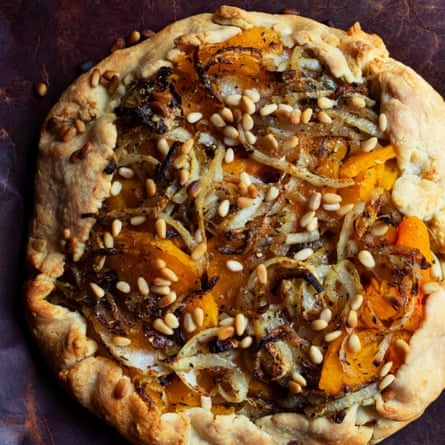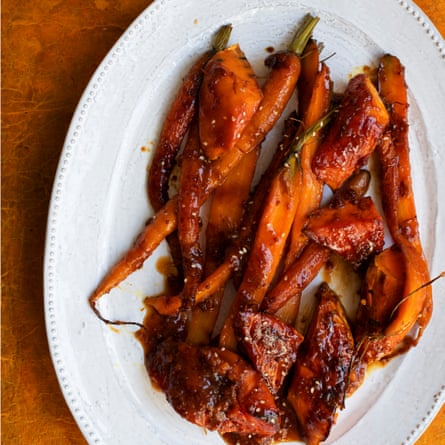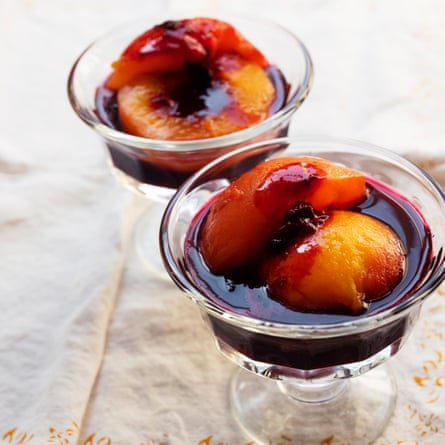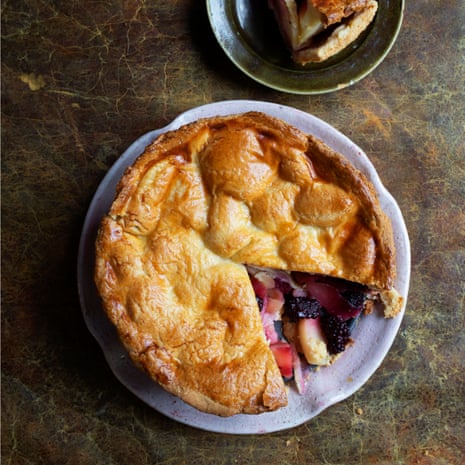The market stalls are a tapestry of ochre and dark green. There are fat pumpkins and bunches of cavolo nero; early parsnips and chard entwined with late peaches and blackberries. There are apples for a pie, the first local pears (conference, as crisp as a sheet ice) hazelnuts and the first chestnuts. Food shopping doesn’t get better than this.
The first pumpkins are startling, their presence a sudden reminder that the year is waning. I might buy one or two for the house – simply for the beauty of their curves and dimples, but as far as cooking goes, they can wait a week or two. They will have much work to do this winter – and, instead, I bring home a shiny-skinned and user-friendly butternut. Destined to end its days as a tart filling with onions and pine nuts, the butternut weighs less in the bag than the fat turban pumpkins. I will steam the flesh and tuck it into the filling of pie. This is the first of the vegetable pies and tarts that I look forward to so much as the evenings darken.
Later, there will be potato-topped pies of mushrooms and cream, of smoked haddock and dill and deep-filled chicken pies. Their tops will be golden brown, decorated with pastry leaves and berries but, for now, the pastry is folded loosely over the filling, to expose its orange-bright filling.
The summer’s carrots are fattening up. Better for grating than the pencil-thin roots of early summer. Their flavour more earthy. Some will be treated as if for remoulade, the resulting matchsticks tossed in a mustardy mayonnaise with chopped parsley. Others will be cut in half lengthways and roasted, then tossed with a mixture of chopped green olives and lemon or with an intense miso and mustard paste. The first will sit aside grilled plaice, the miso carrots being eaten with steamed brown rice or smoky green wheat.
There may be sweet pie, too: deep blackberry and apple if I have the patience (I do) or apple crisp if not – the topping of oats, demerara and butter made in the blink of an eye. That pie will be served warm with cream or cold with a slice of ivory-hued caerphilly.
The peaches have been a little hit and miss this year. Fruits have been luscious or lacklustre as the mood takes them. The flat white ones have fared better, though I refuse to call them “doughnut” peaches. At this late hour in the season, you can pull the fruits apart with your hands, twist out the stone and add the scarlet-edged flesh to a salad of Parma ham and green olives.
The larger fruits, turmeric yellow and scented like roses, have been eaten noisily, but those that have failed to ripen have been poached in syrup and served with a sauce of either blackcurrants or blueberries.
Autumn is where the year starts for me. Where our cooking shakes itself from its sleepy summer haze. It is when the cake tins and pie dishes come out; the casseroles come down from the shelf and when the real cooking starts again.
Deep apple and blackberry pie
An apple pie so deep it can be served by the thick slice and eaten as you might eat a cake. The spicing of the apples – with cinnamon, lemon and nutmeg – is mild, and the blackberries add a hint of tartness. I use sweet dessert apples for this rather than bramleys, which are prone to cook down to a froth – good for baked apples but not so appropriate for a deep-sided pie such as this. This is not a recipe to be rushed, so take your time.
Serves 6-8
For the pastry
plain flour 300g
cold butter 150g
icing sugar 2 tbsp
egg yolk 1 large
egg 1, lightly beaten
For the filling
sweet dessert apples 1.8kg
lemon 1
golden caster sugar 2 tbsp
ground cinnamon a knifepoint
nutmeg a little, grated
blackberries 200g
You will also need a 20cm cake tin, 6cm deep, with a loose bottom, preferably with a spring clip.
Make the pastry by putting the flour into the bowl of a food processor, adding the butter, cut into small cubes, then reducing to coarse crumbs. If you prefer, rub the cubes of butter into the flour with your fingertips. Stop when they look like fresh, coarse breadcrumbs. Add the icing sugar, then the egg yolk and then enough water to produce a firm, rollable dough. I start with one tablespoon, then add a second (and occasionally a third). Remove the dough from the bowl, pat into a ball then wrap in baking parchment and refrigerate for 30 minutes.
For the filling, peel the apples, dropping each one into a bowl of water you have acidulated with the juice of half of the lemon (it will stop them browning). Quarter, core and thinly slice them, dropping them back into the water as you go.
Drain the apples, then put them in a medium-sized, stainless-steel saucepan with the sugar, cinnamon, nutmeg and the juice of the remaining lemon half. Bring to the boil then reduce the heat to a simmer till the apples are tender but still hold their shape – about 10-15 minutes. Stir from time to time then remove from the heat and leave them to cool.
Set the oven at gas mark 6/180C fan and place a baking sheet on the middle shelf. Very lightly butter the sides and base of a 20cm loose-bottomed, non-stick cake tin. Remove the pastry from the fridge, cut off a little less than a third of it, then return that to the fridge. Roll out the larger piece of pastry and use it to line the base and sides of the tin. Make sure to seal any tears or cracks that appear (otherwise your pie will leak). Place a piece of baking parchment over the pastry and the sides of the tin and fill with baking beans, then bake for 15 minutes on top of the hot baking sheet. Lift out and carefully remove the paper and beans. Return to the oven for a further five minutes until the pastry feels dry to the touch.
Remove the pastry-lined cake tin from the oven. Lower the temperature to gas mark 4/160C fan.
Fill with the apples, adding the blackberries as you go then set aside. Remove the small piece of pastry from the fridge and roll out to fit the top of the cake tin. Brush the edge of the pastry in the tin with the beaten egg. Lower the pastry over the apple and blackberry filling and press the pastry edges together to seal. Brush the pastry with beaten egg, pierce two or three small slits on the surface (to stop the pastry splitting as it bakes) and bake for 45 minutes till golden.
Remove from the oven and leave for a good 15-20 minutes to settle before running a palette knife carefully around the edge and opening the spring clip and removing the tin.
Butternut and pinenut tart

There is much to be said for a dish that is as good cold as it is hot from the oven. The tart that follows is such a recipe. The butternut – or pumpkin, if you prefer – sits on a bed of softened onions, flecked with thyme and pine kernels. The onions are cooked till thoroughly soft and golden, then loosely encased with the butternut in parmesan pastry.
Serves 6
For the pastry
plain flour 150g
butter 90g
water 1 tbsp
grated parmesan 40g
For the filling
onions 2 medium
olive oil 2 tbsp
butternut squash or pumpkin 1kg
dried thyme 1 tsp
pine kernels 1 tbsp
Make the pastry by putting the flour and a generous pinch of salt into a large mixing bowl. Dice the butter and crumble the flour and butter together between your fingertips and thumbs, to the texture of soft crumbs. Stir in the parmesan then enough water to give a firm but rollable dough. Start with a tablespoon and see how you go. (Using a food processor you can do this in seconds.) Shape the dough into a ball, wrap in kitchen paper and refrigerate for 30 minutes.
To make the filling, peel the onions and slice them into thin rounds. In a shallow pan over a moderate heat, warm the olive oil then add the onions and fry for 10 minutes or so, stirring regularly, till they have softened. Add the dried thyme and a grinding of salt and pepper, then cook for a further 10 minutes, until the onions are soft and golden; set aside.
Peel the butternut squash or pumpkin and discard the seeds and fibres from its core. (Strictly speaking, it is unnecessary to peel a butternut, but I prefer it without the skin for this.) Cut the butternut into slices roughly 1cm in thickness, then place them in a steamer basket or colander. Place them on top of a pan of boiling water, cover with a lid and steam for 8 minutes or until tender. Remove and set aside.
Roll the rested pastry out on a lightly floured board into a round roughly 30cm in diameter. Set the oven at gas mark 6/180C fan.
Transfer the pastry to a baking sheet lined with baking parchment, then place the slices of butternut, slightly overlapping, over the pastry leaving a 2cm rim all around the edge. (They will be very tender, but don’t worry if they break up a little.) Season with a little salt and black pepper. Scatter the onions over, brushing the butternut with any oil from the pan. Fold the outer edge of the pastry in, to loosely cover the edge of the butternut and onions, then scatter with pine kernels.
Bake the tart for 25 minutes till golden brown.
Sweet potato and carrots with miso

The sweetness of carrots can take the intense savoury hit of a dark brown miso paste. I sweeten the miso with honey and stir in a little mustard, too, making a dressing that can be used to baste the carrots as they roast. This was intended as a side dish, but I have been eating it as a main course. Keep an eye on the carrots towards the end of cooking – you want them sticky and caramelised. (I recommend a non-stick roasting tin.)
Serves 4 as a side dish or 3 as a main dish with rice
sweet potato 500g
carrots 500g
olive oil 3 tbsp
brown miso 90g
mirin 75ml
honey 3tbsp
grain mustard 1 tbsp
sherry 80ml
to serve:
steamed brown rice
Preheat the oven to gas mark 6/180C fan. Peel the sweet potatoes. Scrub the carrots. Cut the sweet potatoes into large chunks, about the size you would for roast potatoes, then cut the carrots in half lengthways (and in half again, if they are particularly large).
In a roasting tin, heat the olive oil over a moderate heat then add the sweet potatoes and carrots and let them brown lightly on the underside, then turn and lightly brown the others. Transfer the roasting tin to the oven and leave for about 40 minutes till the vegetables are tender to the point of a knife.
Meanwhile, put the brown miso in a small saucepan, add the mirin, honey, mustard and sherry and bring to the boil, stirring as the mixture warms. Remove from the heat. Remove the vegetables from the oven and pour over the sauce, making sure the sweet potatoes and carrots are lightly covered. Return to the oven for 15 minutes until the sauce is bubbling and caramelised.
Serve with steamed brown rice.
Roast aubergine quinoa

I often roast vegetables, tomatoes, onions, marrow or some sort of autumn squash in my largest roasting tin, then pick at them for the next couple of days. They make a fine accompaniment, but can also be added to cooked grains or lentils. Quinoa is rarely my first thought when I’m rummaging through the jars in the larder but here it works well, the grains sponging up the toasty juices from the olive-oily vegetables. I should add that I have also eaten this cold, the day after making it, and it was very good, too.
Serves 4-5
aubergines 500g (2 medium)
courgettes 250g
marrow 450g
olive oil 6-8 tbsp
red chillies 2 small and hot
garlic 2 cloves
spring onions 3
cumin seeds 1 tsp
ground coriander 1tsp
tomatoes 300g
quinoa 75g
parsley, mint and coriander leaves 30g total weight
Preheat the oven to gas mark 6/180C fan. Cut the aubergines in half lengthways, then into large pieces about 4cm thick. Cut the courgettes into similar-sized pieces. Peel the marrow, remove the seeds and core and again cut the flesh into similar-sized pieces.
In a roasting tin over a moderate heat, warm the olive oil then add the aubergines and courgettes and marrow and cook until the sides are golden – about 10 minutes – turning from time to time. Peel and finely slice the garlic, finely chop the chilli (removing the seeds first, if you wish) then stir into the aubergines. Roughly chop the spring onions and add to the pan.
Add the cumin and coriander, continue cooking for a minute then transfer to the oven and roast till the ingredients are soft and tender – about 40-50 minutes. Cut the tomatoes in half then add to the roasted vegetables and return to the oven for 15 minutes.
While the vegetables are roasting, cook the quinoa in boiling, lightly salted water for 20 minutes. Roughly chop the parsley and mint. When the grains are tender, drain and gently stir into the roasted vegetables with the herbs, check the seasoning and serve.
Peaches with blackcurrant sauce

There are still some decent peaches around, though this has hardly been the best of years. (I have had several batches that refused, point blank, to ripen and those that did were less than juicy.) You can cook these, in their skins, in a bath of sugar syrup and they will yield deliciously to the heat.
Serves 4
For the sugar syrup
granulated sugar 120g
water 500ml
cloves 4
cinnamon stick half
lemon ½
peaches 4
For the sauce:
blackcurrants 200g, fresh or frozen
the syrup, above, 100ml
Make the sugar syrup: put the granulated sugar in a medium-sized saucepan – I use a deep 20cm saucepan – add the water, cloves, cinnamon and lemon and bring to the boil. Halve the peaches and remove their stones. When the water has dissolved the sugar, lower in the peaches and turn the heat down so the fruit simmers gently and cooks for 10-20 minutes, depending on the ripeness of the fruit.
Remove the blackcurrants from their stalks, then bring them to the boil in a small saucepan with 100ml of the peach syrup until the fruit starts to burst and the juices have turned deep purple.
Check for tenderness with the point of a knife or skewer then remove the fruit and reserve its cooking syrup. Remove the skin from the fruit – it should slip off easily, then place in a serving dish, spooning over the blackcurrant syrup as you serve.
@NigelSlater
